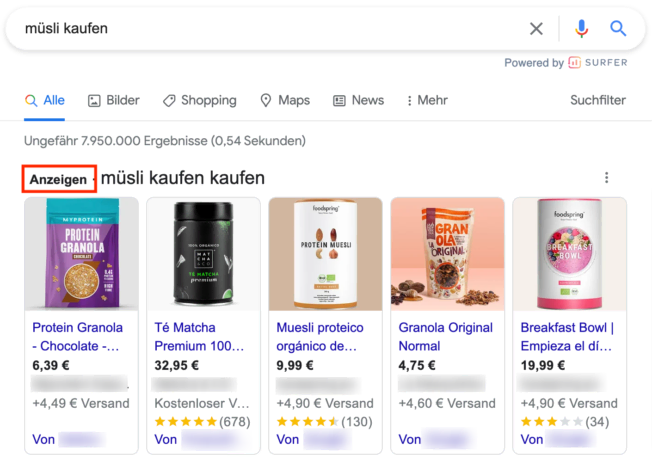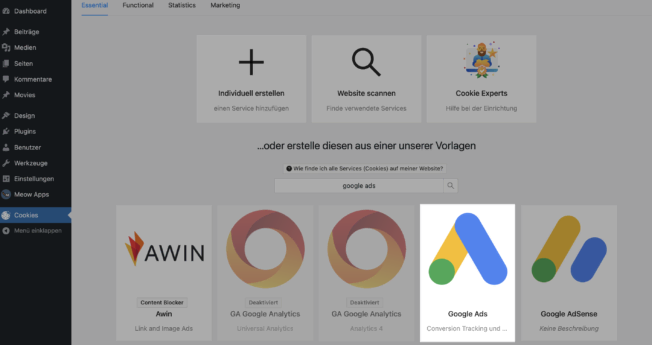The popular tracking tool from Google is part of the standard repertoire for almost every online marketer. The Google Ads Conversion Tracking is an excellent helper when it comes to measuring success and optimizing campaigns.
However, there are a few things you should keep in mind when integrating the Google tool on your WordPress website to avoid privacy violations and high fines.
What exactly this is and how you can use Google Ads Conversion Tracking in a privacy compliant way, we will tell you in this article!
What is Google Ads?
As the name suggests, Google Ads is an advertising platform of the tech giant Google. Thus, Google Ads joins other services like Google Analytics and Google Maps.
But what exactly is Google Ads? Formerly known as Google AdWords, you can create profitable online campaigns using the Google service.
The service allows businesses and advertisers to target billions of users as they, for example, perform queries in Google Search, watch videos on YouTube, explore new places with Google Maps, discover apps on Google Play, or browse content on the web.
Source: Google Ads
Google Ads are displayed as paid ads in the Google search results. These are marked as advertisements. You’ve probably seen this before:
Google Ads are part of Search Engine Advertising (SEA) and thus counterpart to Search Engine Optimization (SEO), the organic search engine optimization.
The great advantage in the use of paid advertisements (SEA) is the high visibility in the search results, due to the placement in the first places. Disadvantage, however, are the costs that must be paid to Google, if the click price (CPC) is high.
Google Ads is based on the auction principle. That means: The highest bidders get the best places. However, this also means that – depending on the competition and the relevance of the topic – you may have to dip into your piggy bank. But: This is not necessarily the case. For example, if you use more relevant keywords but bid less than your competitors, your ad may still be preferred.
Finally, you pay per click. The higher the click price, the higher the costs you may have to pay.
Besides search ad, which you can see in the screenshot above, Google also offers the ad campaign type shopping campaign.
What is the difference between Google Ads and Google Adsense?
Attention, danger of confusion! Even though both services sound almost identical, they differ immensely. Roughly summarized, you can remember the following difference between Google Ads and Google Adsense:
- Google Ads: You place ads in Google search and on various websites. You spend money.
- Google Adsense: You place ads on your website and receive a certain amount of money for each click. You earn money.
Google Ads and privacy
Now that you have a rough overview of what Google Ads actually is, let’s get to the actual topic of the article: privacy-compliant embedding of Google Ads conversation tracking on a WordPress website.
Google Ads belongs to Google. And that Google and privacy are two seemingly incompatible things is no secret. One of the biggest problems here is Google’s headquarters in the USA.
Why?
Since the end of the Privacy Shield – a data protection agreement between the EU and the US – the US has been considered an unsafe third country. The ECJ overturned the agreement, classifying the level of data protection in the U.S. for EU citizens as inadequate.
At the same time, Google Ads collects personal data – such as the IP address – for measuring the success of campaigns and the targeted playout of ads. These advertisements are processed in the USA, among other places.
However, the processing of personal data and forwarding to the USA may not generally take place without the active and informed consent (opt-in consent) of the website visitor.
A major problem from the perspective of the GDPR is the conversion tracking provided by Google Ads. This is because the tool can be used to identify users and record their behavior after interacting with the ad (which products they bought or added to their shopping cart, newsletter signups, etc.). User behavior can even be tracked across multiple pages. This makes it easier for advertisers to measure the success of the Google Ads campaign. The collected data is linked to the advertising data in the Google Ads advertising network.
Likewise, the data can be used for remarketing. This means that users who have already clicked on an ad within the Google Ads advertising network can be served personalized and targeted ads again.
To enable tracking, the notorious cookies are also used. In addition to processing personal data, the setting of non-essential cookies also requires consent. “Non-essential” means not technically-necessary for the basic functionality of the website. You also need opt-in consent for this.
How to integrate Google Ads Conversion Tracking into your website in a GDPR-compliant way
Now that we’ve finished all the legal blah blah, let’s finally get to the part of the article you’re here for: the GDPR-compliant integration.
In order to use Google Ads tracking as privacy compliant as possible on your website, you should meet the following criteria.
✅ Opt-in consent
Let’s start with the topic of consent. As you already know, you need to get consent for setting tracking cookies and processing personal data (to the US). The easiest way to get consent is to use a consent management tool like Real Cookie Banner.
The cookie plugin helps you to quickly & easily obtain opt-in consents à la GDPR. You need neither programming knowledge nor legal expertise 😉
And it gets even better: A ready-to-use service template for Google Ads Conversion Tracking is already available in the Real Cookie Banner!
How exactly, we’ll show you now!
- Open your WordPress backend.
- Go to Cookies > Services (Cookies) > Add Service in the left menu.
- Search the templates for Google Ads.
- Click on the template. Now you’ll land in the service configuration. Since the template is already filled in, you don’t need to do anything here except enter your Google Ads Conversation Tracking ID in the appropriate field. Where exactly you can find your tracking ID, you can see in the following screenshot.

-
- Scroll down.
- Confirm that you have checked all the data and click Save.
- That’s it! Now Google Ads Conversion Tracking will be played out after the consent of your visitor in the cookie banner – and the GDPR is happy 😉
In Real Cookie Banner PRO you also have the option to obtain a special consent for data processing to the USA. You can find this in your Real Cookie Banner dashboard under Settings > Consent and you should activate it in any case.
🤝 Data processing agreement
We have thus concluded the topic of opt-in consent. Let’s now move on to the next step, the Data processing agreement (DPA).
An data processing agreement is based on GDPR Art. 28 and must always be concluded if you commission an external company with the processing of personal data (e.g. of customers, visitors or users). Roughly speaking, the DPA specifies the data protection-compliant handling of this data.
📝 Privacy policy
Finally, you must nmention Google Ads Conversion Tracking in your privacy policy. Here you need to explain, among other things, why you use the service, what data is transferred and to whom it goes. This way, you ensure that your website visitors know exactly what happens to their data.



